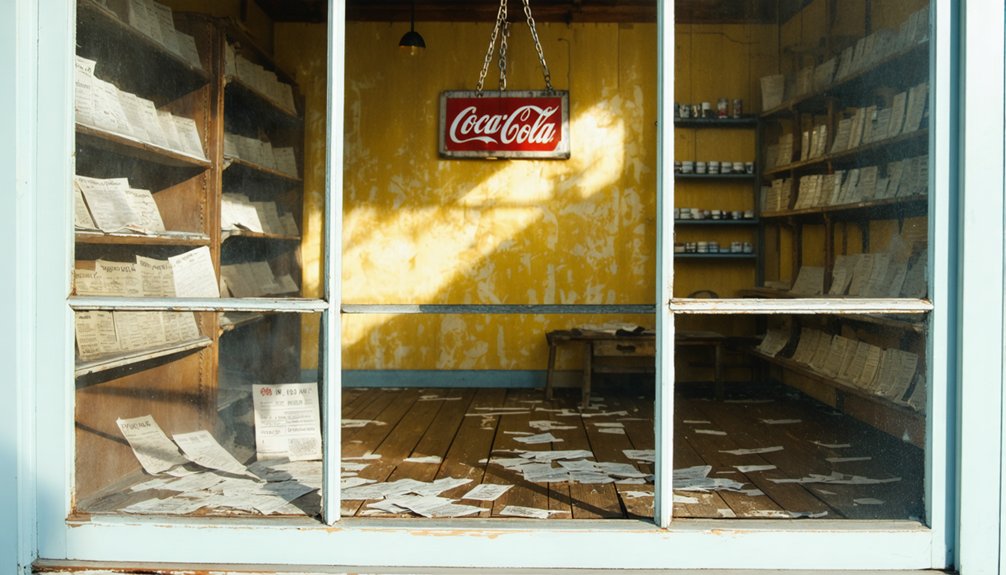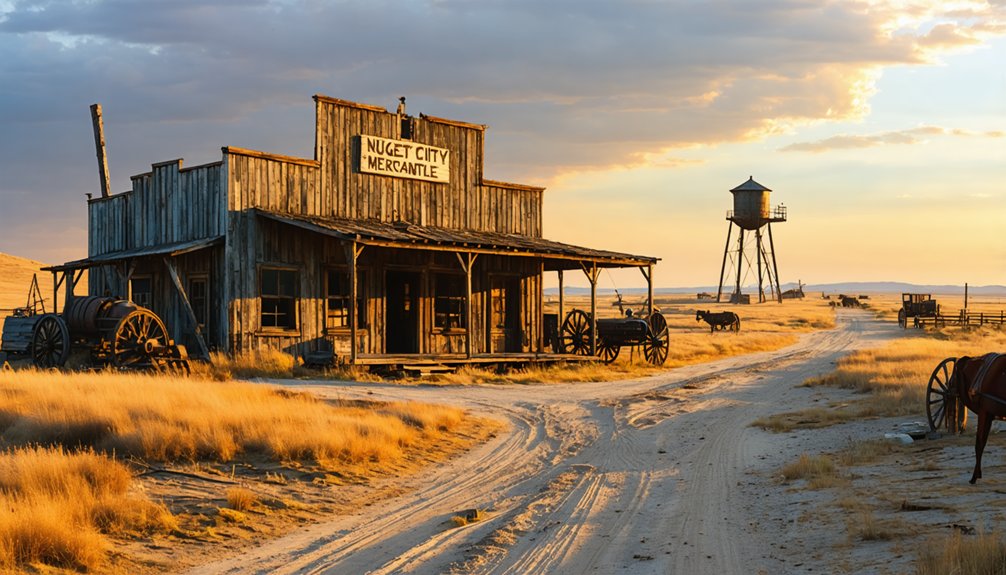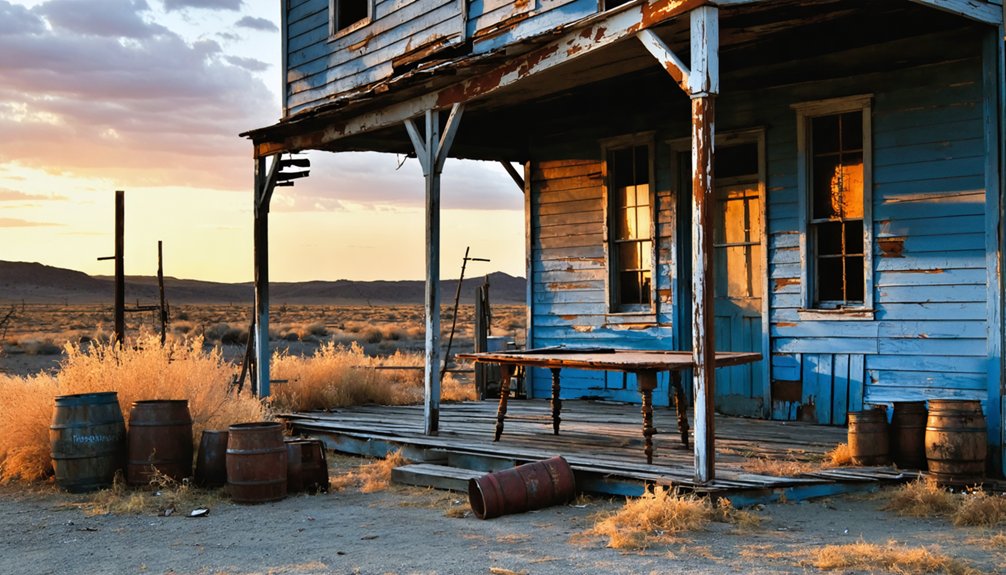You’ll find Nugget City’s ruins in South Dakota’s Black Hills, where it emerged during the 1876 gold rush. Initially called Nugget City after the Manuel brothers’ strike, this boomtown attracted diverse miners from around the world, supporting saloons, churches, and newspapers during its peak. By the early 1900s, depleted ore deposits led to its decline, and by the 1970s, it was completely abandoned. Today, collapsed shaft houses and building foundations tell a rich story of frontier ambition.
Key Takeaways
- Nugget City emerged during the Black Hills Gold Rush in 1898 and flourished through mining operations before becoming completely abandoned by the 1970s.
- Archaeological remains include collapsed shaft houses, headframes, and building foundations that reveal the town’s original layout and mining infrastructure.
- The town served as a significant mining hub in Lawrence County, establishing its own newspaper and supporting both placer and underground mining operations.
- Located in the rugged Black Hills, the site features elevations between 5,000-6,600 feet and contains preserved evidence of historical mining activities.
- Motorized access is restricted by Forest Service regulations, with guided tours recommended for exploring the ghost town’s historical remains.
Origins of Nugget City’s Mining Heritage
While the Black Hills remained Lakota territory under the Fort Laramie Treaty, the discovery of gold in 1874 sparked an unstoppable rush of prospectors into the region.
By fall 1875, a rich gold deposit in the northern Black Hills drew thousands to the Deadwood Gulch area, where you’d find the origins of settlements like Nugget City taking shape.
The mining heritage of Nugget City emerged alongside neighboring camps as prospectors staked their claims along creeks and gulches. Miners used rocker box systems to separate valuable gold from gravel and sand deposits. The Sioux people were aware of the precious metal but considered it completely useless for their purposes.
Though Nugget City’s exact founding date remains unclear, it developed during the pivotal period when the Manuel brothers struck gold near Lead in April 1876.
Like other Black Hills settlements, Nugget City’s early miners focused on placer mining, washing gold from creek gravels and alluvial deposits before evolving to more industrialized methods.
Life in a Black Hills Boomtown
As miners flooded into Nugget City and surrounding Black Hills settlements in 1876, a vibrant boomtown culture quickly took shape.
The Black Hills gold rush sparked an explosion of frontier life as fortune seekers poured into makeshift settlements during 1876.
You’d find a mix of single men and families creating distinct social dynamics, with saloons, dance halls, and gambling houses dominating the main street. Cultural diversity thrived as miners from Wales, Germany, and China brought their customs to town. The local Gold Nugget Beer became a favorite drink among the miners and residents.
Life wasn’t easy – you’d face primitive housing conditions, starting with tents and log cabins. Disease, accidents, and violence were common threats. The devastating fire of 1876 destroyed over 300 buildings and left 2,000 residents homeless.
Yet community spirit emerged as churches, schools, and newspapers established themselves. Beyond mining, you’d see a bustling economy of hotels, blacksmiths, and supply stores.
While law enforcement remained spotty, the settlement gradually transformed from a rough camp into a more structured frontier town.
Geographic Features and Natural Resources
Located in the rugged Black Hills of western South Dakota, Nugget City sits amid a dramatic landscape of steep slopes, deep canyons, and limestone cliffs.
You’ll find the town positioned near the Wyoming border at elevations typical of the Black Hills plateau, ranging from 5,000 to 6,600 feet.
The area’s geological formations tell a fascinating story, with ancient Precambrian granite at its core surrounded by younger sedimentary rocks. Early miners discovered deposits of galena ore deposits scattered throughout these formations.
Rich mineral resources, particularly gold veins within metamorphic and igneous formations, drew prospectors to this region.
Multiple streams, including Spearfish Creek, cut through the terrain, creating thousand-foot-deep canyons while providing essential water for mining operations.
The landscape’s diverse vegetation zones range from ponderosa pine forests at higher elevations to mixed grasslands below, all adapted to the region’s humid continental climate. The area receives notably higher precipitation levels compared to the surrounding western plains due to its elevated terrain.
Mining Operations and Economic Peak
The Black Hills’ rich mineral resources sparked a dramatic mining boom that would shape Nugget City’s destiny. What began as simple placer mining in the 1870s quickly evolved into sophisticated operations by the 1880s, as prospectors shifted from creek panning to underground mining. The early days of mining saw significant activity along Deadwood and Whitewood Creeks, where many prospectors found their fortune.
The region’s mining innovations transformed the industry, particularly after Homestake Mining Company‘s dominance. You’d have seen remarkable advances: compressed air locomotives replaced mules, Charles Merrill’s cyanidation process improved gold recovery, and deep shaft mining reached thousands of feet underground. The mine’s depth eventually reached an impressive 8,000 feet deep, making it one of the deepest mines in North America.
These developments delivered impressive economic impacts, with Homestake producing over 43 million troy ounces of gold throughout its lifetime. By 1906, the mine’s annual ore production exceeded 1.5 million short tons, creating thousands of jobs and driving the area’s growth well into the 20th century.
The People Behind the Gold Rush
When gold’s discovery sparked a mass migration to the Black Hills in 1874, nearly 15,000 settlers flooded the region within just two years, defying both federal law and Native American territorial rights.
You’d find a diverse mix of risk-takers among these fortune seekers – experienced miners, gamblers like Wild Bill Hickok, and countless inexperienced prospectors driven by dreams of striking it rich.
Settler motivations centered primarily on quick wealth, leading to rapid boomtown development and widespread cultural conflicts with the Sioux, whose sacred lands were being invaded.
Life in mining camps wasn’t easy – most men lived in basic boardinghouses for $1 a night, surrounded by saloons and gambling halls.
While some entrepreneurs established businesses serving the mining community, many settlers lived precariously, facing high mortality rates from violence, accidents, and harsh conditions. The Treaty of Fort Laramie had established these lands as part of the Great Sioux Reservation just six years earlier.
The discovery began when Custer’s expedition found gold traces in French Creek during their military exploration of the region.
Transportation and Access Routes
As settlers poured into Nugget City during the gold rush, accessing this remote Black Hills location presented significant challenges. Early miners relied on narrow dirt trails, using horse-drawn wagons to transport supplies from Deadwood and Lead.
Mining operations depended entirely on manual and animal labor to move gold out along these primitive routes.
Gold-laden wagons creaked along rough trails as laborers and pack animals toiled to transport precious cargo from remote mines.
Today, you’ll face your own access challenges when visiting this ghost town. You’ll need to navigate forest service roads branching off U.S. Highway 14A, and high-clearance vehicles are essential for the rough terrain.
There’s limited signage, so you’ll want GPS coordinates handy. Winter conditions and rainfall can make roads impassable, while Forest Service regulations restrict motorized access to protect historical sites.
Consider joining guided tours if you’re unsure about tackling the rugged approach independently.
Decline and Abandonment Timeline

Founded during the waning years of the Black Hills Gold Rush in 1898, Nugget City experienced a dramatic rise and fall within just a few decades.
As mining operations flourished initially, the town drew settlers and prospectors seeking their fortunes in the region’s gold deposits.
Economic factors triggered the town’s decline in the early 1900s when ore deposits became depleted or too costly to extract.
Population dynamics shifted dramatically as mining jobs vanished, causing businesses to shutter and families to relocate to more prosperous areas.
By the 1940s, you’d have found Nugget City largely deserted, with only a handful of determined residents remaining.
The exodus continued until the 1970s, when the last inhabitants departed, leaving the town completely abandoned.
Today, nature has reclaimed much of what was once a bustling mining community.
Remaining Traces and Archaeological Findings
Despite decades of abandonment, significant archaeological traces of Nugget City’s mining heritage remain visible today.
You’ll find collapsed shaft houses, headframes, and building foundations that outline the original town layout. Alongside the creek beds, evidence of placer mining operations and coal mining infrastructure persists, including coke oven bricks and discarded miners’ tags.
Recent archaeological discoveries have unearthed fascinating mining artifacts and personal items.
Excavations of privy sites have revealed pre-Prohibition whiskey bottles, medicine bottles, and domestic items like figurines and pottery shards. The most telling finds are clustered in creek beds and gravel bars, where seasonal flooding continues to expose new artifacts.
These well-preserved remains allow researchers to reconstruct daily life and industrial processes from Nugget City’s bustling mining era.
Notable Events and Historical Significance

When gold was discovered in the Black Hills region in 1874, Nugget City emerged as one of many mining settlements that would shape South Dakota’s economic landscape.
By 1886, the town had established its own newspaper, The Nugget, signaling its growth into a structured community during the height of the mining boom.
The town’s significance stems from its role in the broader Black Hills Gold Rush, where it served as a hub for placer mining operations in Lawrence County.
You’ll find its story intertwined with the complex history of settler expansion into Lakota Sioux territory.
Like many similar settlements, Nugget City’s eventual shift to a ghost town mirrors the classic boom-and-bust cycle that defined Western mining communities, marking a significant chapter in South Dakota’s mining heritage.
Legacy in Lawrence County History
As one of Lawrence County’s historic mining settlements, Nugget City left an enduring mark on the region’s development alongside prominent towns like Deadwood and Lead.
You’ll find its legacy preserved through Lawrence County Historical Society‘s records and local preservation efforts, joining other ghost towns like Carbonate and Tinton in telling the story of the area’s rich mining heritage.
The town’s cultural impact mirrors the broader patterns seen across Lawrence County, where mining operations drove population growth and infrastructure development.
Today, you can explore this history through the county’s fifteen historical markers and extensive archival records.
While Nugget City may be silent now, it remains part of the larger narrative that established Lawrence County as one of the Black Hills’ most significant mining regions.
Frequently Asked Questions
Were Any Famous Outlaws Known to Have Visited Nugget City?
You won’t find records of any notorious criminals or outlaw sightings in this small mining camp. While outlaws frequented larger Black Hills towns like Deadwood, they weren’t documented visiting here.
What Types of Entertainment and Social Activities Existed in Nugget City?
Like moths to a flame, you’d find miners flocking to saloons for drinks, gambling, and music. Social gatherings included campfire storytelling, while recreational activities centered on impromptu dances and mining celebrations.
Did Nugget City Have a School or Church During Its Existence?
You won’t find evidence of a school building or church services in historical records. While nearby mining towns had these institutions, there’s no documentation confirming their existence in this location.
What Was the Average Cost of Living in Nugget City?
You’d have spent $2-4 daily on basic living expenses, with historical prices showing meals at $0.25-0.50, weekly lodging at $1-2.50, and mining supplies varying based on availability.
Were There Any Documented Conflicts Between Miners and Native American Tribes?
Mining disputes marked multiple conflicts between settlers and Sioux tribes during the Black Hills Gold Rush. You’ll find documented battles and territorial tensions stemming from treaty violations and sacred land encroachment.
References
- https://usghostadventures.com/deadwood-ghost-tour/
- https://www.sdpb.org/rural-life-and-history/2023-08-21/some-black-hills-ghost-towns-and-their-origins
- https://www.youtube.com/watch?v=_0WNYsFLSLA
- https://www.sdhspress.com/journal/south-dakota-history-2-3/the-boom-and-bust-of-central-city/vol-02-no-3-the-boom-and-bust-of-central-city.pdf
- https://www.blackhillsbadlands.com/blog/post/old-west-legends-mines-ghost-towns-route-reimagined/
- https://en.wikipedia.org/wiki/Carbonate
- https://blackhillsatvdestinations.com/gold-rush/
- https://en.wikipedia.org/wiki/List_of_ghost_towns_in_South_Dakota
- https://truewestmagazine.com/article/biggest-nugget-in-the-black-hills/
- https://en.wikipedia.org/wiki/Homestake_Mine_(South_Dakota)



